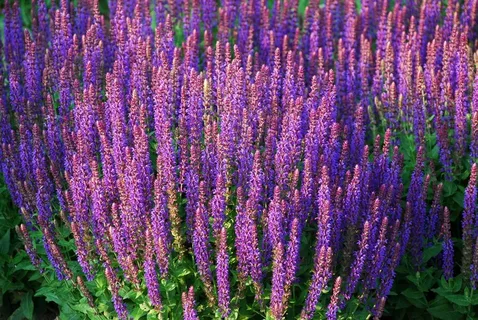Table of Contents
- About the Salvia Plant
- Brief Overview of The Salvia
- Why Should You Pick Salvia Plants?
- Common Problems with Salvias Plants
- Things Required to Grow Salvias
- Tackling Common Problems of Salvias
Salvias have a very lengthy flowering cycle, which makes them a popular choice for gardens. The genus Salvia has a wide range of bloom, color, smell, and plant behaviors. Salvias offer a delicious crop while drawing beneficial insects and pollinators such as hummingbirds, bees, and lepidoptera. One less thing to worry about is that salvia plants repel wildlife such as deer, rabbits, and more. This genus features low-maintenance, laid-back plants that are ideal for any garden, including herbs, shrubs, and subshrubs.
After planting the salvias, it is your responsibility to ensure their success. You may apply a remedy to solve any issues you may have with growing salvias, so don’t worry. This post will outline frequent issues with salvia plants and provide solutions so that both your salvia and other plants thrive.
Concerning the Salvia Plant
The Lamiaceae family, also known as the sage family, includes the Salvia genus. They are indigenous to the Americas, the Mediterranean, and China. They are utilized as fragrant, decorative foliage as well as herbs and ornamental plants. These plants increase the biodiversity of your garden and draw in a wide variety of pollinators, which improves its aesthetic appeal and hardiness. Annuals, shrubby, herbaceous perennials, and sensitive perennials are the four primary types of salvia.
A Synopsis of The Scientific Name for Salvia
- Common Name: Annuals / Perennials Sage Plant
- Hardiness: H3–H7 Colors: Multicolored
- Sun: bright light or partial shadow
- Height: between 0.5 and 1 m
- Disperse: 0.5 – 1 m
Why Is It Better to Choose Salvia Plants?
Salvia plants like full light and a south-facing location to grow in. Certain kinds can even thrive in partial shade. Salvia plants prefer well-draining environments. These are perfect for any garden since they require little care. While some kinds require overwintering, others can remain in the ground throughout the winter.
Bring indoors container-grown salvia plants, shield outside plants from cold and rain, maintain the leaves, and cover with mulch in the wintertime to safeguard your salvia. If needed, horticultural fleece can also be used. Autumn is not the time to prune or chop back, since dead stems should be preserved for animals.
Sage is a resilient perennial salvia plant that bears leaves all year round. Sage can even be harvested after the first year of planting. To harvest for immediate use, cut using secateurs or scissors, or preserve for later use. In either case, you won’t ever run out of sage in your kitchen. Before the salvia flowers bloom, harvest in the spring or summer. The scent of the leaf is not as strong after flowering, therefore picking this late in the year may have long-term negative effects on the health of your plants.
Whether you are a novice or an experienced gardener, salvia plants are an excellent option. You may choose from a number of types, and they require little maintenance.
Typical Issues with Salvia Plants
You don’t have to worry about pests or illnesses while caring for salvia plants. However, factors like unfavorable weather and inadequate maintenance will make your plants die. Let’s examine the issues that may impact your salvias and how to resolve them.
1. Poor Flowering
There might be several reasons why your salvia plants aren’t blossoming properly, but the most common one is that they were planted in the incorrect location and aren’t receiving enough sunshine. Your salvia should be moved to an area that gets more sunshine. When relocating the salvia flowers, be sure to note when they bloom.
2. Short Flowering Course
Salvias bloom for a considerable amount of time in the summer. The salvias’ flowering time will be shortened if you don’t deadhead them. This occurs as a result of the plant’s preference for seeds over blossoms. By deadheading, you may extend the blooming season and savor the beautiful blossoms.
3. Leggy Plants
Salvia plants might develop lanky as a result of inconsistent watering. Maintain a regular watering routine and give your salvia plants frequent attention. A further reason might be the absence of sunshine. Salvia plants require full light to thrive. The stems and leaves droop as they search for the light if they are partially shaded.Your salvia plants should be moved to a more sunny area. When the new growth adjusts over a few weeks, it won’t appear lanky or elongated.
4. Root Rot
One of the most common concerns with salvias is waterlogging, which damages the roots and leads to fungal infections and root rot. You’ll notice yellowing, stunted development, and withering leaves on your salvia. Whether your salvia is growing on the ground or in containers, you need to make sure that any extra water can simply drain away.
5. Floppy Salvia Plants
Your salvia plants may be floppy due to either insufficient sun exposure or excessive rain. The salvia gets soggy from the continuous rain that the root system becomes compressed and lacks oxygen. The weight of the water topples the stems and leaves of the salvia. Take a vacation from watering your plants every day; if necessary, you may even cage or stake them for additional support.
- Winter Damage
Frost can cause harm to the delicate salvia plants. Wintertime is a time to protect the delicate salvias. Even after being damaged by the frost, plants may sprout new growth in the spring. However, the plant has probably died if by June there are no signs of growth. If you reside in a milder climate, you should apply a 10 cm layer of well-rotted manure or organic material around the plants in order to overwinter the fragile salvias. In colder climates, you should bring the vulnerable salvias inside during the winter or plant them in containers with some protection from the elements. If the hardiness of your salvias is on the edge, don’t trim them in the fall.
- Brown Stems
Overwatering is the reason for browning stems and leaves. Stems that are overwatered as a result of excessive rain or an erratic watering schedule can decay and turn brown. The leaves will eventually turn brown. Dry out the soil between waterings to combat this. The leaves and stems will get crispy and become a pale brown color if they don’t have enough water. Cut away the crunchy leaves as soon as possible, and start watering.
- Pests
Although there are a few exceptions, such as garden aphids, caterpillars, Japanese beetles, etc., salvia plants generally do not have a pest issue. Remove or wash off any bugs that you spot on your salvia plants right away.
Items Needed to Plant Salvias
Starting with the correct tools is essential if you want to minimize any problems when producing salvias.
1. Salvia Plants
Salvia plants for your garden may be purchased.
Garden Plant: Salvia Nemorosa Salvatore Deep Blue
Hardy perennial salvia plants suitable for gardening, Salvia pratensis plants
Salvia ‘Lipstick’
2. Salvia Seeds
Sage Hardy Perennial Flowering Garden Plant
You may also buy salvia seeds so you can begin planting right away.
Blaze of Fire Salvia Seeds by Country Value Flower Seeds
Mixed Seeds of Salvia Viridis Bouquet. Sage Clary
VAR.turkestanica Alba Salvia Sclarea 20 seeds in 1 packet (100 total) Violet Queen Salvia Nemorosa Seeds
3.Salvia Plant Pots or Containers
Make sure there is adequate drainage for salvia plants you put in pots or other containers.
Six Pieces Plastic Planters
50PCS/15cm Plastic Flower Pots for Plants
Ten Polypropylene Flower Pots
Six Pieces Plastic Planters
4.Salvia’s Compost
Your salvia plants will thrive and blossom beautifully with high-quality compost.
- Miracle-Gro All-Purpose Compost, 40 Litre Miracle-Gro PEAT FREE PremiumBorder Booster, 60L Multi-Purpose Compost Soil Bag, 5L Organic Compost Soil Bag
Addressing Typical Issues with Salvias
Overall, salvia plants are hardy, especially when it comes to pests, climate adaption, and irrigation problems. Because of their minimal maintenance requirements and laid-back personality, salvias are a popular plant in the UK. Both hardy and delicate cultivars are available in a wide variety. Salvias produce a considerable amount of fruit and flowers because they draw in a lot of helpful pollinators. With adequate drainage, they may be planted both in the ground and in pots or containers. Salvia is a plant that may be grown in a variety of garden settings, including sunny woodlands, woods, kitchen or herb gardens, and tropical gardens.
However, salvias can have a number of issues, such as floppy plants, brown stems, winter damage, pests, leggy plants, limited flowering periods, and poor blossoming. As soon as possible, identify the issue, eliminate it, and take preventative action to avoid similar issues in the future.
You can maintain the health and happiness of your salvia plants in your yard as long as you pay attention to them.
Your garden will continue to blossom all year long with just a few more actions in your routine.




